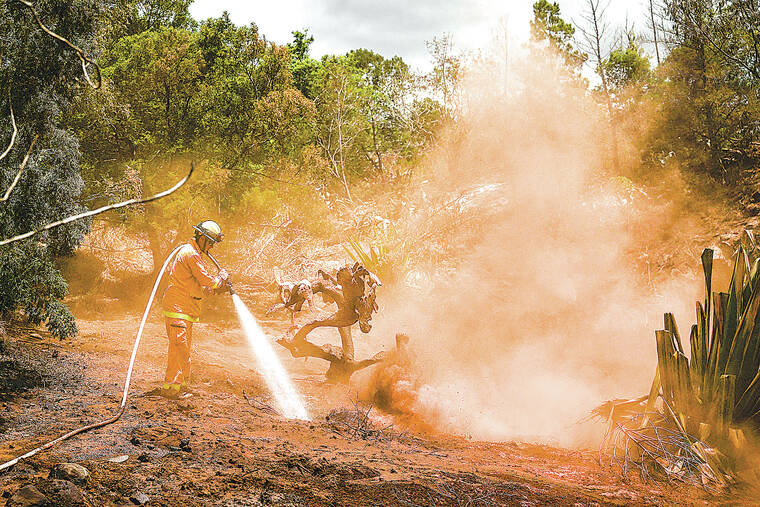After losing their homes, Lahaina parents try to save their school community
KAANAPALI, Maui — The flames that ripped through Lahaina needed only a few hours to take nearly everything from Aina Kohler. Her house. Her surfing school and cafe. And her parents’ home, where she was raised.
Three weeks later, the flames are gone but they have continued to take, robbing Kohler’s 12-year-old son — and hundreds of other children — of what was supposed to be the first few weeks of the school year.
ADVERTISING
The deadly fire Aug. 8 destroyed King Kamehameha III Elementary School in Lahaina and forced all three of the other public schools in town to close until officials determine that the air and water are safe. As of Monday, nearly 60% of the 3,000 public school students in Lahaina, a historic town in West Maui, had not enrolled in another public school or signed up for remote classes, essentially vanishing from the school system.
Kohler’s son, Kimo Varona, whose first day of sixth grade was supposed to be the day after the fire, still hasn’t returned to class weeks later as his family stays at a West Maui house that was offered as a refuge by a family they had never met. Kimo, whose education was already upended by COVID-19 closures, longs for some sense of normalcy with his classmates.
“The kids are having to grow up really fast right now,” said Kohler, a firefighter on Maui who helped respond to the Lahaina blaze and has turned her focus to finding an adequate school program for her son.
In recent interviews, parents and teachers said that they lived in West Maui because of the tightknit community there and that they now fear losing it if the state cannot quickly reopen schools in Lahaina.
There are no obvious solutions for families who find themselves in a situation that was unimaginable a month ago, back when students and parents were buying school supplies and getting excited about their new teachers.
Many of Lahaina’s families are staying with friends or family elsewhere on Maui, in emergency hotels on the island or in other parts of Hawaii. Some have moved to the mainland. Two Lahaina children have been confirmed dead, a 7-year-old boy and a 14-year-old boy, though officials still have not identified most of the 115 victims who are known to have died, and the ultimate death toll is believed to be higher.
For now, the Hawaii Department of Education has offered two options for Lahaina students: take the bus to schools elsewhere on Maui or enroll in a remote learning program, similar to how students learned during COVID-19 closures.
Kohler is considering signing up Kimo for remote classes but believes students should return to school in the West Maui community they know as home as soon as possible. The three other public schools in Lahaina — Princess Nahienaena Elementary School, Lahaina Intermediate School and Lahainaluna High School — remain largely intact, with only some damage from wind, debris and ash.
Teachers and school employees are also struggling to stabilize their lives.
Michelle DeBaldo, a second grade special education teacher at King Kamehameha III Elementary School, has been living in a hotel since escaping the fire, which also burned down her home and charred most of what she owned. At least 103 teachers and employees of Lahaina schools have reported that their homes burned, but all staff members are believed to have survived the fire, Keith Hayashi, the superintendent of the Hawaii public school system, said at a board meeting last week.
Teachers have been on paid administrative leave since the fire. DeBaldo said that she wanted to get back to teaching to help her students but that she did not yet have what she needed to return.
“I miss my kids. I love my job more than anything,” she said. But she added, “How am I supposed to go back to work when I don’t have clothes to work in? I lost everything.”
On Monday, DeBaldo and other Lahaina teachers met at a hotel with Education Department officials and, with many of them crying, shared their stories and criticism.
Earlier, Robert Livermore, a first grade teacher, had organized a meeting along a beach near Lahaina to gather suggestions from parents, frustrated by a lack of information from the state.
He collected about 200 responses, and a vast majority of parents said they were interested in sending their children back to Lahaina if the schools reopened.
In a striking example of the unevenness of the fire’s consequences, in the aftermath of the fire Kimo’s twin sister received a coveted spot at the private Maui Preparatory Academy — 20 minutes north of the burn zone — and quickly returned to school.
But Kimo was not admitted to the school. More than 700 students had applied for admission after the fire, but Maui Prep said it had space for only about 140 of them.
Reuben Pali, who grew up in Lahaina and runs after-school music classes for students, feared that sending children to schools elsewhere on the island — what many on Maui call “the other side” — could exacerbate the loss of community in Lahaina. He noted that many Hawaiians had already left Maui in recent years because they were priced out.
“We’re a tight, small little community,” he said, “and being dispersed is like dispersing a family.”
© 2023 The New York Times Company


